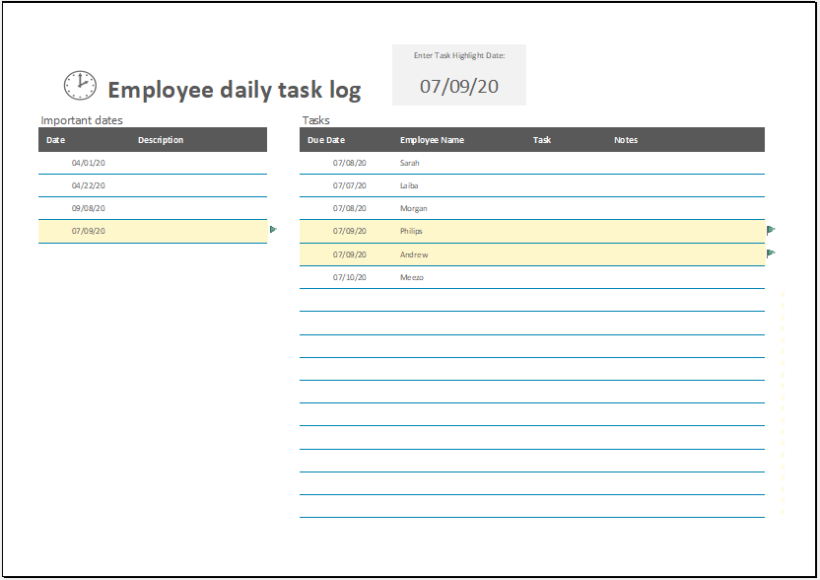
Keeping track of daily tasks and managing time effectively are essential skills for any employee. However, with the fast-paced nature of modern work environments, it can be challenging to stay organized and ensure that all tasks are completed on time. This is where an employee’s daily task log comes in handy.
This article will explore an employee’s daily task log, why it is beneficial, how to create and use one effectively and provide some tips for successful task management.
What is an Employee’s Daily Task Log?
an employee daily task log is a tool that allows employees to record and track their daily tasks, prioritize them, and monitor their progress. It provides a structured framework for employees to plan their day, allocate time to different tasks, and keep a record of completed tasks. The log can be customized to suit individual preferences and work requirements, and it can be used in various industries and job roles.
Why is an Employee’s Daily Task Log Beneficial?
an employee daily task log offers several benefits for both employees and employers:
- Improved Organization: By using a task log, employees can organize and prioritize their tasks effectively, ensuring that important deadlines are met and nothing falls through the cracks.
- Enhanced Productivity: Having a clear overview of daily tasks helps employees stay focused and motivated, leading to increased productivity.
- Time Management: A task log allows employees to allocate time to different tasks strategically, ensuring that each task receives sufficient attention and is completed within the set timeframe.
- Accountability: With a task log, employees can track their progress and hold themselves accountable for completing their assigned tasks.
- Communication: A task log can serve as a communication tool, allowing employees to share their progress and collaborate with team members or supervisors.
How to Create and Use an Employee Daily Task Log
Creating and using an employee daily task log is a straightforward process that can be customized to meet individual needs. Here are the steps to create and use a task log effectively:
1. Determine the Format and Design
Start by deciding on the format and design of your task log. You can create a digital version using spreadsheet software or opt for a template. Consider factors such as the number of tasks you typically handle, the level of detail you want to include, and your personal preferences in terms of layout.
2. Identify Key Sections
Divide your task log into key sections to make it more organized and user-friendly. Some common sections include:
- Date: Record the date for each day’s tasks.
- Task Description: Clearly define each task to ensure clarity and avoid confusion.
- Priority: Assign a priority level to each task to help you determine which tasks need immediate attention.
- Estimated Time: Estimate the time required to complete each task to manage your time effectively.
- Actual Time: Record the actual time taken to complete each task to track your efficiency and identify areas for improvement.
- Status: Track the progress of each task by indicating whether it is pending, in progress, or completed.
- Notes: Use this section to jot down additional details or comments about each task.
3. Prioritize Your Tasks
Before starting your day, review your tasks and assign a priority level to each one. This will help you stay focused and ensure that you tackle the most important tasks first. Consider deadlines, importance, and urgency when prioritizing.
4. Allocate Time Intelligently
Once you have prioritized your tasks, allocate time to each task based on its priority and estimated time required. Be realistic with your time allocation and allow for breaks and unexpected interruptions.
5. Monitor and Update Regularly
Throughout the day, refer to your task log frequently to stay on track and monitor your progress. Update the status and actual time taken for each task as you complete them. This will help you assess your productivity and make any necessary adjustments to your time management strategies.
6. Review and Reflect
At the end of each day, review your completed tasks and reflect on your performance. Use this time to celebrate your accomplishments, identify areas for improvement, and make any necessary adjustments to your task log for the next day.
Example of an Employee’s Daily Task Log




Tips for Successful Task Management
To make the most of your employee’s daily task log, consider the following tips:
- Be Realistic: Set achievable goals and allocate time accordingly. Avoid overloading your task log, as this can lead to stress and reduced productivity.
- Break Tasks Down: If a task seems overwhelming, break it down into smaller, more manageable subtasks. This will make it easier to tackle and track progress.
- Take Breaks: Schedule short breaks between tasks to recharge and maintain focus throughout the day. This will help prevent burnout and increase productivity.
- Eliminate Distractions: Minimize distractions during dedicated work periods. Turn off notifications on your phone, close unnecessary tabs on your computer, and create a quiet and organized workspace.
- Regularly Update and Review: Keep your task log updated throughout the day and review it regularly to ensure you’re on track. This will help you stay organized and minimize the risk of missing deadlines.
- Celebrate Achievements: Acknowledge and celebrate your accomplishments, no matter how small. This will boost your motivation and maintain a positive mindset.
Free Employee Daily Task Log Template!
An employee daily task log is a valuable tool for maintaining organization, managing time effectively, and boosting productivity. By creating and using a task log, employees can streamline their work, prioritize tasks, and monitor their progress.
Remember to customize your task log to meet your specific needs and refer to it regularly to stay on track. With proper task management, you can enhance your efficiency, reduce stress, and achieve your goals more effectively.
Employee Daily Task Log Template Excel – Download